A self-study, self-paced course where you can learn how to paint in watercolor by watching video lessons and doing assignments
$297 USD
ENROLL NOWA self-study, self-paced course where you can learn how to paint in watercolor by watching video lessons and doing assignments
$297 USD
ENROLL NOWOne-to-one, unlimited and custom-tailored to your skills and needs Personal Tutoring by the Watercolor Academy teachers
$997 USD
ENROLL NOWBy Vladimir London, Watercolor Academy tutor
This watercolor is created by Vladimir London for the 7th International Biennial. This exhibition is dedicated to the new techniques, concepts and developments in watercolor.
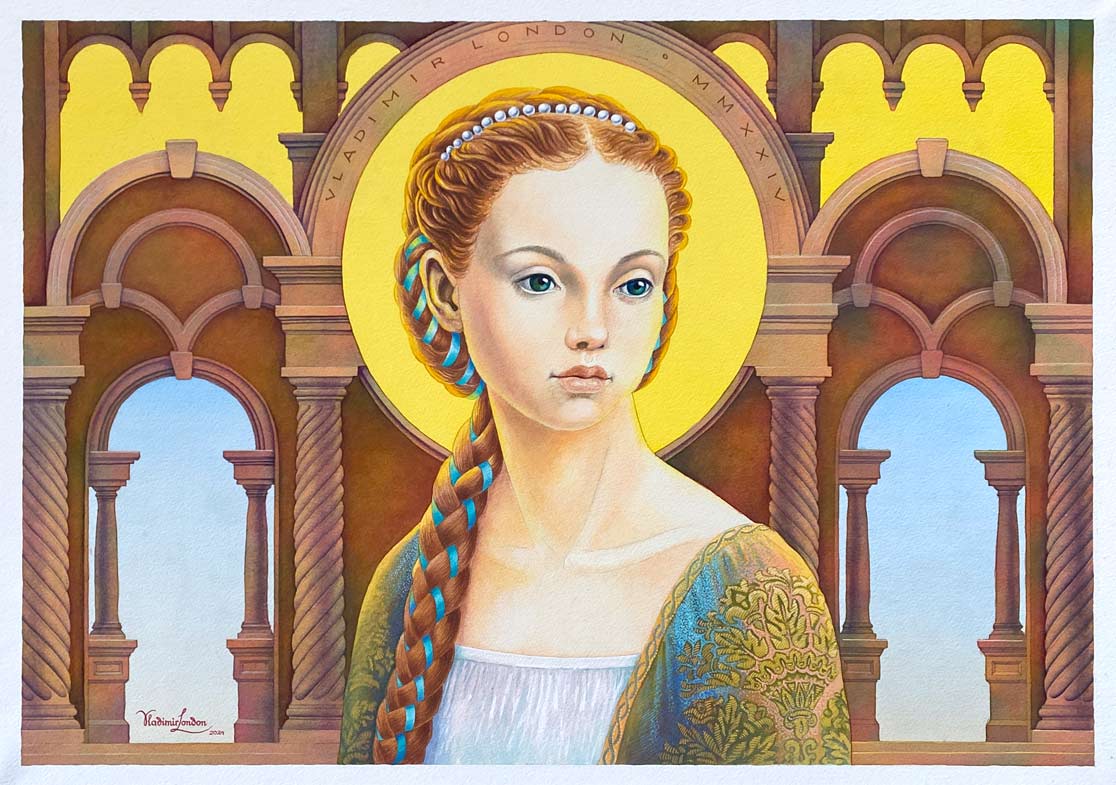
This painting is unique. It has a specially modified binding medium that has never been used in watercolor painting before. The recipe of this water-soluble medium is my know-how and I will explain its properties and benefits later in this video. Also, I will show you all the steps of this artwork creation from the initial drawing to the finished painting.
The composition begins with an idea. It will be a portrait of a young woman depicted from imagination. She will be in the Renaissance dress and placed against the architectural environment. I will quickly sketch her face in the three-quarters view. As I have done thousands of portrait sketches before, this part is the easiest of all. The head is slightly tilted to one side; her face is calm and thoughtful.
I'm using the classical proportions of a human head and face to draw this girl. Also, the anatomical structure is in place to ensure that portrait is realistic. To learn how to draw a portrait, you can check my book "How to Draw a Portrait: Step-by-step Instructions for Beginner Artists" that is available on Amazon.
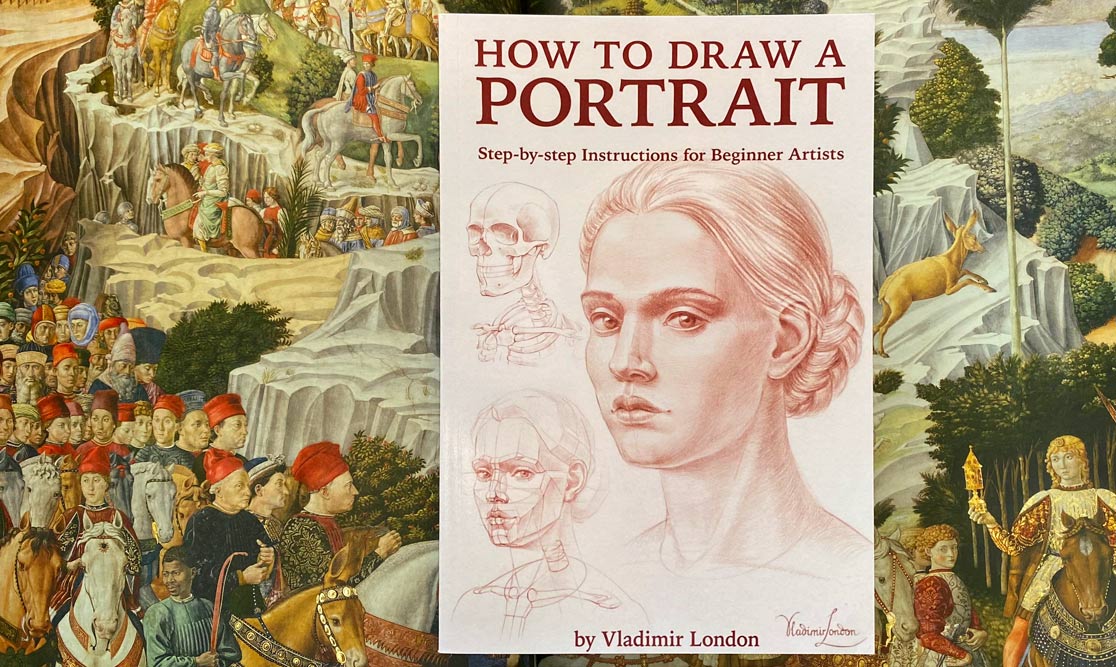
Now, I will outline the architectural background. To make it beautiful, I will use the Golden Mean calipers. Usually, measuring Golden Proportions comes as an afterthought, but this time, I will begin composing a Renaissance building by marking the Golden Grid mesh first. Also, to get precise outlines, I will use a compass and ruler, which is something I do mostly for engineering and architectural plans rather than creative artworks. This background is symmetrical, so one half will be enough for now.
The premium quality paper sheet is stapled to the wooden board. It is cold pressed, made of 100% cotton, and has 300 gsm weight. I mask four edges with a paper tape to keep the margins white. This step is optional, but I would like to have a white unpainted frame as a part of the composition.To prevent water getting under the tape, I will apply a thin stripe of masking fluid along its edge. For this purpose, I will use a cheap synthetic brush. It is dipped into the liquid soap first. This will make cleaning it afterwards easier. The gap about two millimeters wide will be covered with masking fluid. This is the only masking that will be used in this artwork. All other places that I need to preserve from paint will be painted around freehand. Now, it's time to transfer the drawing. It is copied to the tracing paper sheets, which help to keep the watercolor sheet clean. With the drawing transferred, I can now begin painting in color. For pigments, I will be using professional watercolor paints from several manufacturers. My DIY swatch-books are indispensable for making decisions on colors.
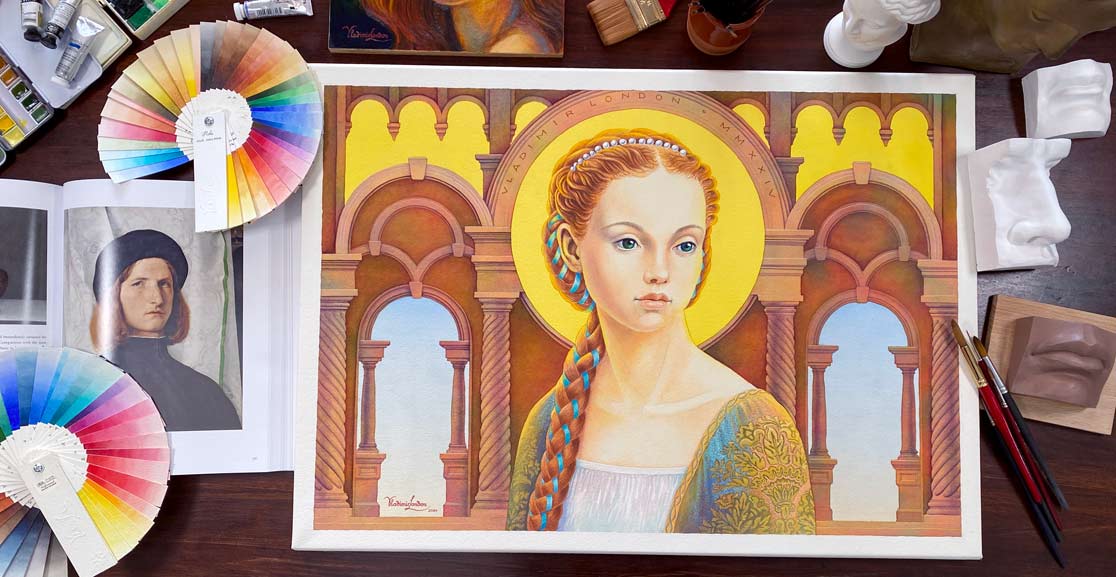
I will begin painting with the yellow-golden background. The sufficient amount of paint is already premixed, and to apply it, I am using the painting method, called "saw-wash". The board is tilted to allow liquid paint to flow down slowly and collect in the bead. The plain wash is the most suitable method for this part of the artwork because I just want a simple one-color, one-tone area filled in with bright yellow color. The reason I turned the board upside-down is to make one continuous wash around the girl's head. Starting from one corner and then rotating the board when needed will make applying this wash easier. This way, the paint flow won't be interrupted by the head into two separate areas, but it will continue as one horseshoe figure around the hairstyle. It's time to turn the board 90-degrees. As you can see, the paint bead is now collected at the bottom of the painted area, which is exactly what I need. Now, I can continue the saw-wash until it will be time to turn the board once again. The yellow part is complete and I will not come back to it, keeping this color bright and vibrant.
To paint the sky, I will use another painting method, called gradated wash. This name tells that the wash won't be plain, but tonal values will change from dark at the top to light at the bottom. To make such a wash, I premixed the needed amount of blue paint and also placed clean water nearby. After each row of paint, I add a bit of clear water into the mix, so it becomes slightly lighter for the next row. I will repeat this procedure row by row until reaching the bottom edge of the sky area. Once again, you can see that I apply paint not in a straight horizontal line, but as a series of short diagonal brushstrokes. Each brushstroke overlaps the previous one. Because these strokes are placed at an angle, paint flows down, crossing each stroke, better intermixing on the paper surface. This way, the wash is smoother and there are no visible borders between strokes and rows of paint. When the first blue gradated wash is fully dry, I can apply the warmer color on top. It will also be painted as a gradated wash. Only this time, it will start not from the top, but from the bottom of this artwork. Usually, the sky is darker and colder at the top and down to the horizon it becomes paler and warmer. To achieve this effect, I'm using not one, but two layers of paint - one cold and another warm on top. A similar effect can be achieved in other ways, but I want to show you how to be in full control over the paint flow while making very soft and gradual transitions of colors and values. This wash has to continue to the very end to prevent a visible border between layers.
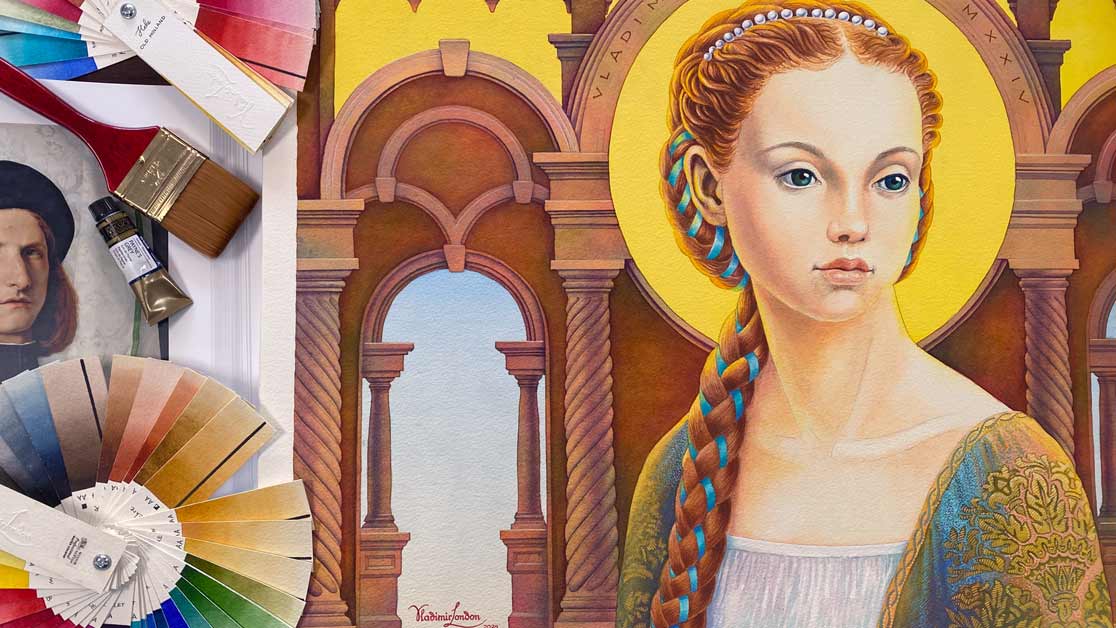
With the sky complete, I will paint the architectural background using this natural Kolinsky brush from Escoda. For this purpose, I premixed eight colors, including primary, secondary, and a couple of tertiary. I will now apply the variegated wash. Its name suggests that colors vary from one to another and intermix directly on the paper surface, softly fusing with each other without any visible borders between different hues. To achieve such a soft mix of colors, mixed paints should have approximately equal tonal values. I apply each color randomly next to each other in small patches. Each patch slightly overlaps the previous one, so paint freely flows from one area to another. This allows transitions between different hues to be very gradual and smooth. Also, it is very important to keep edges of painted areas wet. Ideally, a small bead shall collect at the bottom of the wet area. If paint dries before you finish the wash it would be very difficult to dilute the dry edge to continue uninterrupted wash. Here's another good tip - after applying several patches of different colors, the brush will become muddy. You need to quickly rinse it to load new color with a clean brush. This will help to keep colors vibrant without going into chromatic grays. For rinsing a brush, I keep clean water in the middle of my palette. The whole area of architecture will be covered with such variegated wash of random colors. This will create an interesting effect, as bouncing light reflects from different areas as if the whole building is lit with sunshine, filtered by stained glass windows.
The variegated wash is complete. I can now add details and work out tonal values of the building in the background. A watercolor paint is mixed with my special medium on the palette. As you can see, it is very transparent and gives a light glazing layer that is easy to apply due to special characteristics of my medium. The paint flows well on paper. I am now applying even darker washes on top of underlayers. As you may see, colors of the variegated wash are no longer prominent, but nevertheless, they serve their purpose of imprimatura. I will now paint the girl's face using the wet on wet glazing methods. For this purpose, the paper surface is moistened and paint is applied on top of wet areas, softly diffusing without hard edges.
I will tell you the most interesting thing about this watercolor. To make this artwork, I will be using special watercolor paints that are done to my secret recipe. Such paints have very special properties. No manufacturer makes and sells such watercolors.
Traditionally, watercolor paints are made of finely ground pigments mixed with medium. Usual watercolor medium consists of gum-arabic as the main binder, with addition of plasticizers and dispersants, humectants, extenders and brighteners. It has no chalk and is very transparent. Due to its formula, watercolor paints can be applied very diluted, can easily flow on the paper surface, and even under many layers the white support is visible under multiple layers of very transparent washes. This is what makes watercolor different from other water-based media.
However, traditional watercolor has some major downsides. Because gum-arabic absorbs water, it can be dissolved after it dries. This makes watercolor artworks prone to humid weather and bacteria, which eat gum-arabic and grow inside paper, ruining an artwork with time. Another problem with watercolor is that fine pigment particles sink into paper fibers and undergo the drying shift, when colors become up to 30% lighter when dry. Also, some pigments are prone to lifting, it is when dried paint, when dissolved by upper wet layers, becomes muddy or washed out. To solve these problems, the traditional watercolor medium has to be modified. At the same time, a new watercolor medium has to retain all the good characteristics of the traditional gum-arabic binder and improve those that I mentioned above. To achieve that, I was looking for an answer for a long time, but only after exploring and studying in depth encaustic painting I was able to return to watercolor with a new solution. To explain how it works, I have to say a few words about encaustic.
More than two thousands years ago, ancient Greek and Roman artists used beeswax for painting in color. The beeswax medium was so much associated with painting that the same word was used for both wax and paint. According to Pliny and Vitruvius, who described such a painting medium in their books, pure beeswax has to be treated in a certain way to become suitable for painting. Such modified beeswax was called Punic wax. To this day, researchers and scientists could not agree what Punic wax exactly is. Some say that it is a beeswax that is bleached by triple-boiling in seawater and therefore has reduced amount of fatty acids, others go further, and insist that such a material has to undergo additional treatment with alkali to become water soluble. Whatever the right answer is, this discussion led me to the invention of a new watercolor medium, which I'm using now.
My theory was as follows. It must be the reason why ancient artists used beeswax for making paint medium for centuries. And that reason is found in the unique properties of beeswax. This material is stable and its chemical formula will not change in thousands of years. The Fayum portraits found in Egypt, dated to the first three centuries AD, have bright colors, and remain in better condition than many oil paintings created in the last two hundred years. Bacteria do not eat wax. Beeswax never hardens permanently. This natural material can be softened with moderate heat at any time, so it remains always ready for painting. Beeswax does not change its color with time. It repels water, and high humidity won't affect this medium. Also, beeswax sticks well to any surface, even glossy, so it does not require absorbent grounds. In addition, it seals grounds and prevents them from deterioration. This makes beeswax an ideal binder for paint.
A water-repelling wax that becomes liquid only when it is heated above 65 degrees Celsius, is very antagonistic to what watercolor stands for - water-diluted paint applied in cold state. Combining watercolor and encaustic paints into one mix was an impossible idea until I studied in depth many scientific articles published in the last 50 years. Such articles described various theories about the ancient encaustic art and reported many scientific researches on paints, pigments, binders and media used by Greek, Roman and Egyptian artists in the past. I found the answer in one scientific research that led me to the invention of a new watercolor medium.
A beeswax can be treated in certain ways to become white, more transparent, less fatty, and fully soluble in water at a room temperature. This treatment is not easy nor fast. A natural beeswax has to be boiled in sea water with high amounts of sodium chloride (NaCl) and other sea salts, such as calcium, potassium chlorate (KClO3), magnesium chloride (MgCl2 - 6 H2O) with addition of sodium bicarbonate (NaHCO3). The white wax foam that floats on the surface of boiling water has to be skimmed and rapidly cooled in cold water, where it becomes solid, light and brittle due to small air bubbles trapped inside. This process has to be repeated at least three times. During this treatment, wax loses some amount of its fatty acids that turns into metal salts. Other impurities dissolve in water and wax becomes white in color. Then, this modified wax has to be dried under the sun for at least three months. Thereafter it can be heated and melted together with colophony and damar resins to become a binder for encaustic paints.
Colophony is an important ingredient in this medium. It is not water soluble and is a very stable material. We know these qualities too well because even millions of years do not destroy colophony, it simply turns into beautiful amber. Having such a resin in a watercolor medium would be a definite plus.
You can see how I used such DIY paints for making a hot-beeswax portrait in the video "Best Encaustic Portrait in the Last 2000 Years"
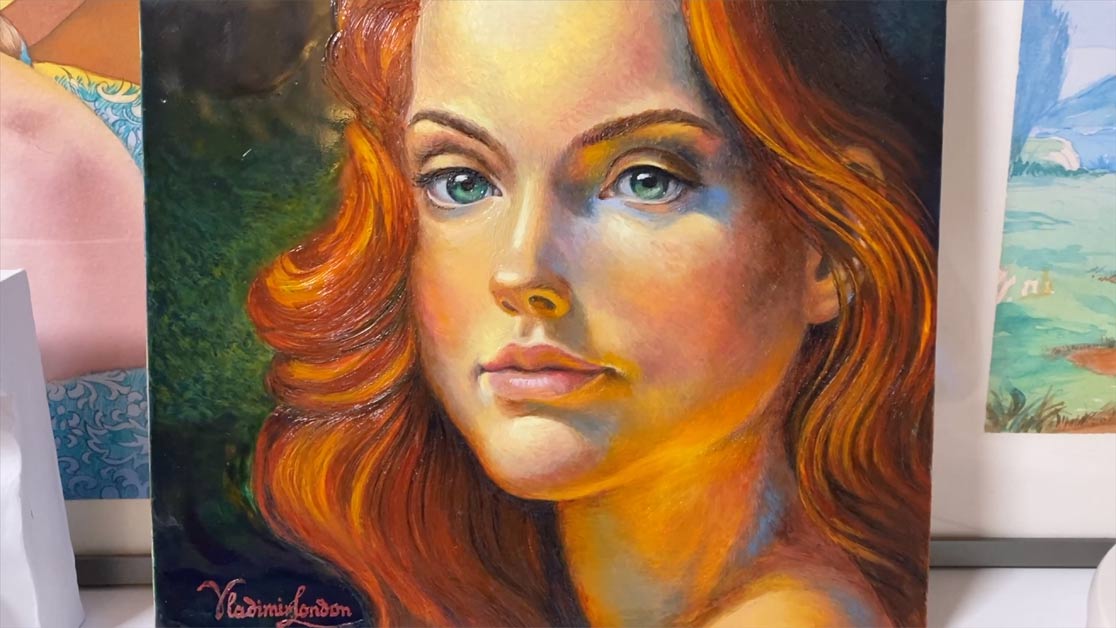
However, to be suitable for watercolor, such treated beeswax has to be additionally modified with potash, an alkaline potassium compound. Colophony, together with wax also undergoes saponification:
C19 H29 COOH (colophony acid) + K2CO2 (potash) => C19 H29 COOK (abietin soap) + CO2 (gas).
Then, this abietin soap has to be boiled in sea water again to get into reaction with sea salts:
C19 H29 COOK + (CaCl2, CaSO4, MgSO4, MgCl2) => (C19 H29-COO)2 Ca(Mg) (metal abietin soap).
This treatment drastically changes the physical properties of Punic wax that is mixed with resin. It becomes water soluble when cold, which makes it possible to be mixed with gum-arabic watercolor paints. Despite only a small amount (under 10%) of saponified wax containing metal soaps is added to watercolor, it changes properties of paint the following ways:
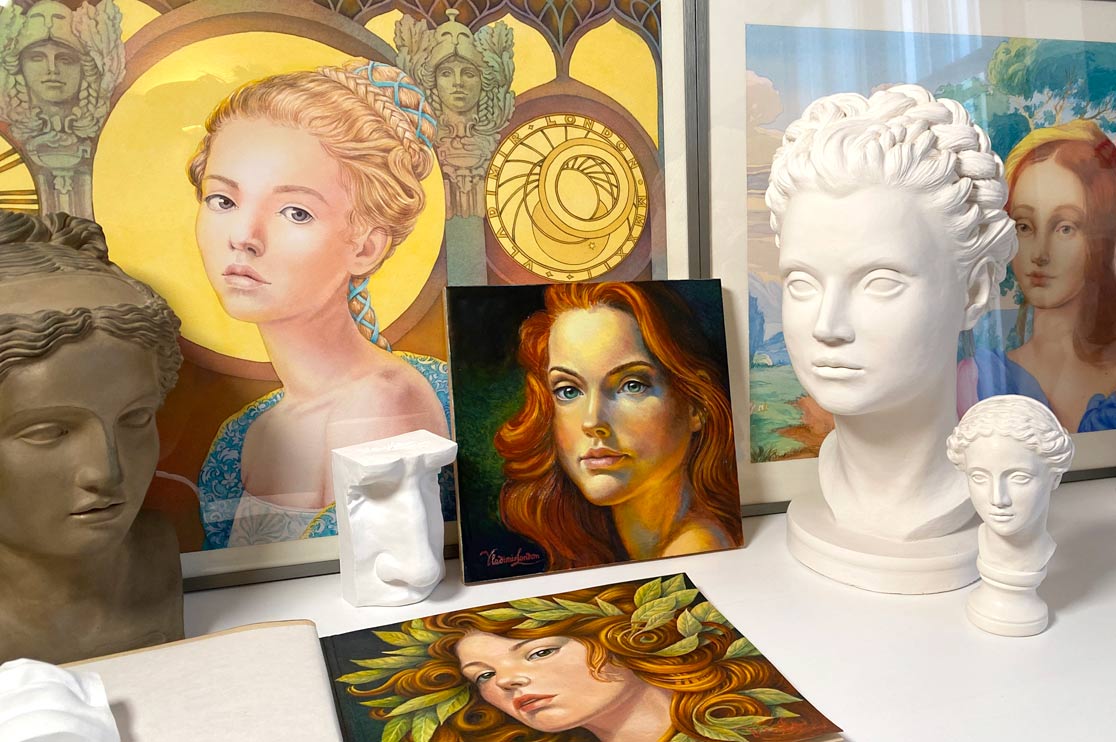
In this artwork, I combine two media - pure watercolor and modified Punic wax watercolor. For example, the girl's face is painted with the addition of wax and resin, while her hairstyle will have an underpainting in pure gum-arabic watercolor with layers of wax medium on top. Such top layers will create an interesting decorative effect that could not be obtained in any other way. Another good thing about this modified medium is that despite containing beeswax and colophony, it is fully water-dilutable before it dries for several days.
However, there are some restrictions that this new watercolor medium comes with. Because it contains wax, it will repel water after it fully dries and it would be difficult to apply washes of well-diluted pure watercolor on top of the areas treated with modified watercolor medium. This is not a bad thing after all, because it might act as a weak, but integrated masking fluid, which could be used for the advantage of a well-planned workflow.
With my extensive experience in watercolor, I know how many layers will be applied for every element of this work, and which paints will be used for each layer. There are several good rules a proficient watercolor artist should follow when painting in multiple layers. For example, for underlayers, it is better to use transparent paints with finer pigments. Coarse, big-size particle pigments should go on top. The painting process should develop from light to dark. And cold colors appear better when placed on top of warm underpainting. There are many more tips and tricks a watercolor artist must know and I described them in my "Book on Watercolor" that is available on Amazon.
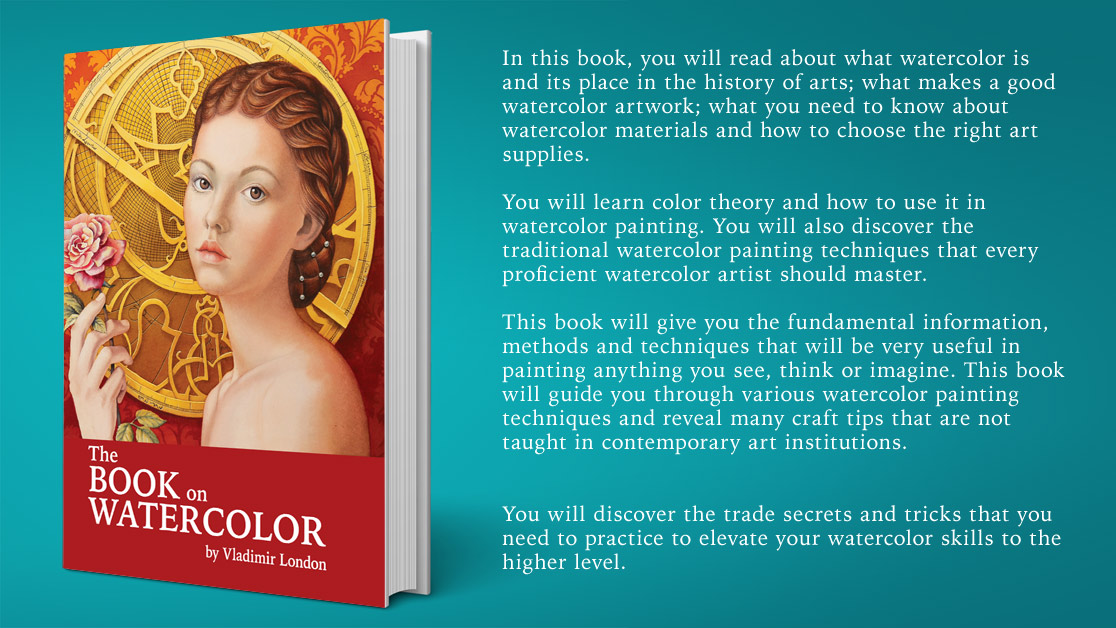
What you see in this video is not just a pure watercolor paint, but modified Punic wax and colophony binder added to the traditional medium in small quantities. This is the very first watercolor artwork that has been done in such a way in the last 2000 years. I cannot say much about art that has been created before that time because old books do not mention mixes of gum-arabic with Punic beeswax and there are no surviving artworks that can be chemically examined for addition of waxes in watercolor paints.
Because a very small amount of Punic beeswax is added to paints here, this medium is still called watercolor, only modified with saponified water-soluble wax containing metal soaps. Nevertheless, even a small amount of such wax adds certain characteristics and improves qualities of a watercolor medium.
A self-study, self-paced course where you can learn how to paint in watercolor by watching video lessons and doing assignments
One-time payment - Lifetime membership
$297 USD
One-to-one, unlimited and custom-tailored to your skills and needs Personal Tutoring by the Watercolor Academy teachers
One-time payment - Lifetime membership
$997 USD